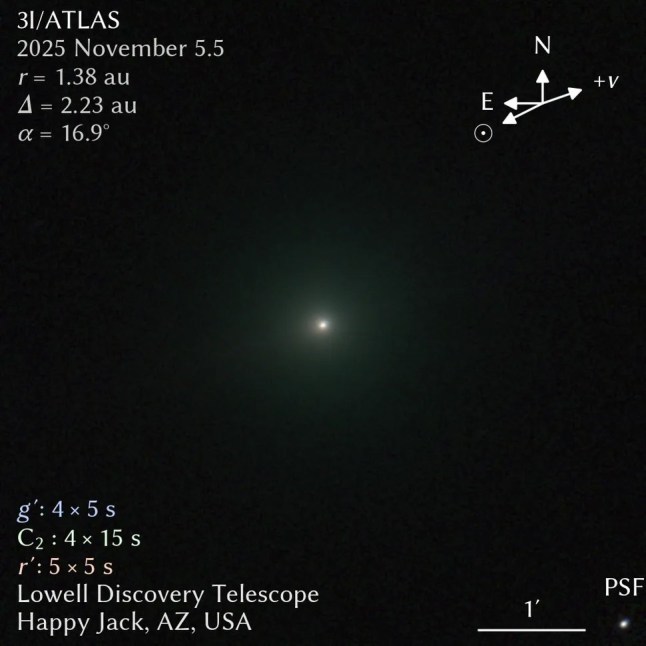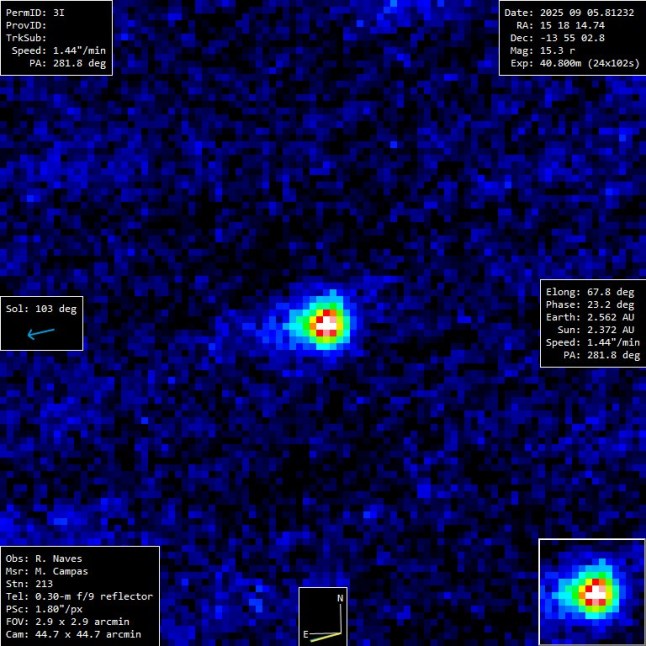
Our solar system’s interstellar visitor – 3I/ATLAS – apparently has ‘jet thrusters’, a scientist has suggested.
The comet is the third time an object not from our star system has wound up in our celestial neighbourhood, which happens from time to time.
For the most part, 3I/ATLAS has behaved like your standard, run-of-the-mill comet – a gigantic, dirty snowball made from dust that orbits the sun.
Some believe it’s anything but this, with Harvard astrophysicist Avi Loeb proposing the object could be of alien origin, such as a probe.

He’s once again questioning what this object is after new images of the space rock were shared this week.
One sighting described yesterday by the Austrian astronomer Michael Jäger captured a ‘complex tail structure’.
The sighting captured a halo stretching half a million kilometres into space and seven ‘jets’, eruptions of gas from under the comet’s surface as it warms up.
Dr Loeb told Metro: ‘Is the network of jets associated with pockets of ice on the surface of a natural cometary nucleus, or are they coming from a set of jet thrusters used for navigation of a spacecraft?’
‘We do not know. For now, let us enjoy the view. After all, a picture is worth a thousand words.’
The clump of ice was also spotted by Arizona’s Lowell Observatory and the Ramon Naves Observatory in Spain as it slinked away from the sun.


Dr Loeb said the images of the object show it appears ‘intact’ and has a ‘compact source of light’.
‘The coma is not very different in morphology than its appearance in the Hubble Space Telescope on July 21, 2025,’ he said, referring to the fuzzy aura comets have as the sun vaporises ice.
Dr Alfredo Carpineti, an astrophysicist and science writer for IFLScience, says there are many explanations for this week’s images, however.
‘3I/ATLAS is a dynamic object. It’s not a comet cutout in a nativity play,’ Dr Carpineti told Metro.
‘It is supposed to change. If its tail was blown away [by solar winds], it is perfectly natural.’
Why the celestial visitor has no tail might be even simpler than that, the author of the upcoming astronomy book, Invisible Rainbows, said.

To view this video please enable JavaScript, and consider upgrading to a web
browser that
supports HTML5
video
‘Some observations suggest we simply are aligned in such a way we can’t see it at the moment,’ he said.
In other words, because we’re seeing the tail roughly head-on, it’s right behind the comet.
Dr Loeb has put the odds of an artificial origin for the 3.5-mile-wide 3I/ATLAS at 40%, questioning how it already had a tail long before it came close to the sun and has an odd chemical composition.
As it made its closest approach to the sun last month, it even brightened considerably and flashed a blue-green hue.
Dr Loeb has even noted that it arrived in the solar system from roughly the same direction as the ‘Wow! Signal’, an alphanumeric sequence detected in 1977 scientists have never quite been able to explain.
‘If the hypothesis about a technological artifact ends up being correct, then there are two possible implications: first that the intentions of 3I/ATLAS are entirely benign and second that they are malign,’ Dr Loeb said.

‘In the first case, humanity need not do anything but await the arrival of this interstellar messenger with open arms. It is the second option which is of great concern.’
But for Dr Carpineti, humanity has no need to worry just yet.
Nasa has said that the comet poses no threat to Earth and will only get as close to us as a whopping 17million miles on December 19 before ending its brief holiday in the solar system.
‘They claimed 3I/ATLAS would manoeuvre towards Earth at the closest point to the sun,’ Dr Carpineti said. ‘That day came and went, the comet still on its orbit, coming nowhere near Earth.
‘The boys who cry “alien” should probably get a new line now.’
Why does 31/ATLAS glow green?
As comets approach the sun, the ice heats up and turns to gas, releasing dirt and giving the icy clump a fuzzy hue called a ‘coma’.
Its atmosphere includes carbon-based that get ‘sunburnt’ by our star’s ultraviolet light, breaking them apart and creating dicarbon.
Qicheng Zhang, a researcher at the Lowell Observatory, told Live Science that he detected dicarbon, made up of two chunky carbon molecules that glow emerald.
As the comet’s ice is vaporised, dust particles trapped within get released. The solar radiation and solar wind blow it from the comet’s core, called a nucleus, creating a tail.
When comets get baked by a star, they don’t warm up all at once. Instead, the side facing the sun heats up and, if any spots are weak, gases under the surface shoot up, called jets.
Get in touch with our news team by emailing us at webnews@metro.co.uk.
For more stories like this, check our news page.









